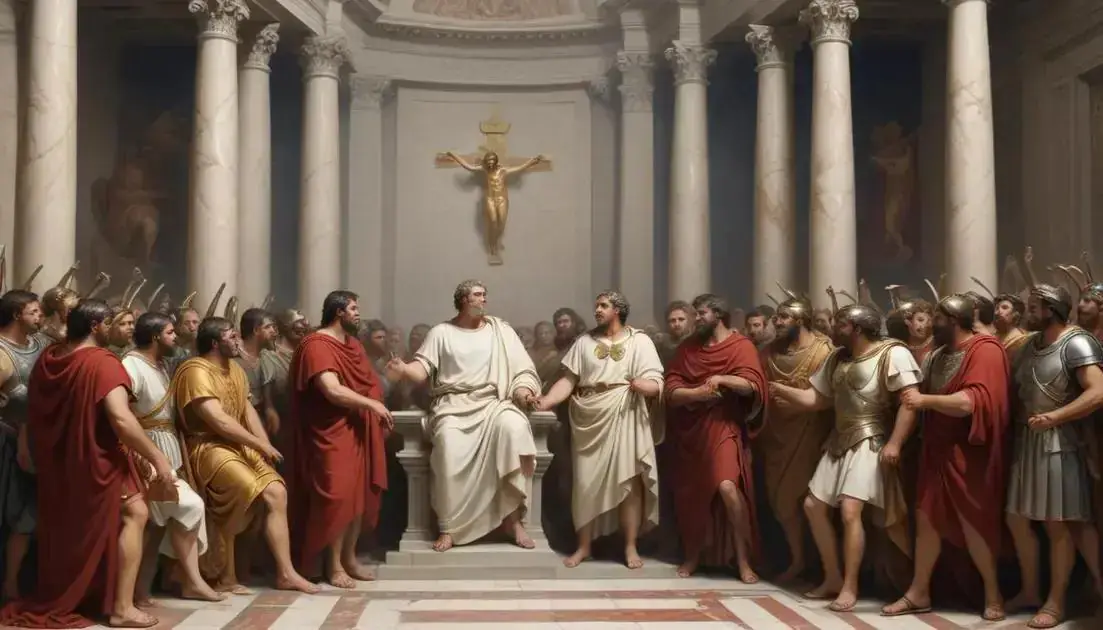
Christian Rome: From Marginal Sect to Active Community
The early development of Christianity in Rome saw it grow from a marginalized sect to a prominent religion despite facing significant persecution. Key figures like Peter and Paul played crucial roles in spreading Christian teachings, while Roman culture influenced community organization and worship practices. Persecution strengthened bonds within the Christian community, fostering resilience and dedication to their faith. This journey laid the foundation for Christianity’s future growth and influence throughout the Roman Empire.Christianity in Rome made significant strides by the 3rd century, evolving from a fringe belief system into a structured and influential community. Have you ever wondered how such a transformation took place?
The early development of Christianity in Rome
The early development of Christianity in Rome was fascinating. It all began in the 1st century when followers of Jesus started spreading His teachings. They met secretly in homes or catacombs to avoid Roman persecution.
Many of these early Christians were from various backgrounds. They included Jews, Greeks, and Romans. Despite their differences, they united over their shared beliefs. They celebrated together, shared meals, and supported one another, creating a strong sense of community.
As more people joined, the church began to grow. The message of love and hope resonated with many. Early Christian leaders, like Peter and Paul, traveled widely, preaching and forming new communities wherever they went.
However, it wasn’t always easy. Christians faced challenges and persecution from authorities. Some were arrested, while others were martyred for their faith. Yet, these hardships only strengthened their resolve and faith.
Worship and rituals were essential in the early church. Christians gathered regularly for prayer and worship, often celebrating the Eucharist or communion. They also shared stories and teachings from the Scriptures, which helped them grow in their faith.
Over time, the influence of Christianity began to spread across the Roman Empire. More people started to recognize its value. By the 3rd century, Christianity was well established in Rome, setting the stage for its significant role in shaping Western civilization.
Key figures in the establishment of the Christian community
Many key figures helped establish the Christian community in Rome. They played vital roles in spreading the teachings of Jesus and nurturing believers.
One important figure was Peter, one of Jesus’ closest followers. He traveled to Rome and became a leader in the early church. Peter helped guide new Christians and encourage their faith.
Another significant figure was Paul. He was not one of Jesus’ original disciples, but he had a powerful conversion experience. Paul dedicated his life to spreading Christianity. He traveled extensively, sharing the message and founding communities.
In addition, there were many other leaders who played crucial roles. They included women like Priscilla and Phoebe, who supported the church’s growth. They helped teach and minister to others and showed that everyone could contribute.
Early Christian leaders also faced challenges. They often dealt with persecution and opposition. Despite this, these figures inspired many others to join the faith.
Together, they laid the groundwork for a strong and vibrant community. Their efforts led to the spread of Christianity beyond Rome, connecting people across different regions.
Influence of Roman culture on early Christianity
The influence of Roman culture on early Christianity was significant. As Christianity spread, it adapted to the cultural landscape of the Roman Empire. This blending helped the faith grow and attract new followers.
One major aspect was the use of language. Latin became the primary language of the church in the West. It allowed the teachings of Christianity to reach a broader audience.
Another influence was the organization of communities. Romans had established ways of governance and social structure. Early Christians adopted some of these ideas to form church leadership and community roles. This helped create a sense of identity and order.
Roman art and architecture also impacted how Christians expressed their faith. They built churches that reflected Roman styles. These buildings became places for worship and community gatherings.
Additionally, Roman philosophies inspired early Christian thinkers. Concepts like justice and ethics were explored in a Christian context. This helped shape beliefs and teachings within the faith.
Despite these influences, Christianity maintained its core message. The teachings of Jesus continued to guide believers. The blending of cultures created a unique expression of faith that appealed to many.
The transition from a marginal sect to a prominent religion
The transition of Christianity from a marginal sect to a prominent religion is truly remarkable. In its early days, Christians faced many challenges. They were often persecuted and seen as outsiders in Roman society.
However, the teachings of Jesus resonated with many people. More individuals began to embrace Christianity, drawn by its message of love and hope. This growing interest helped the faith gain momentum.
As more followers joined, Christian communities became stronger. They provided support to one another. These communities offered a sense of belonging that many sought.
By the 3rd century, the number of Christians had increased significantly. They began to influence various aspects of Roman life. Their beliefs affected social norms and moral standards, challenging the status quo.
The Edict of Milan in 313 AD was a turning point. It granted religious tolerance and allowed Christians to practice their faith openly. This was a significant victory for the church.
With state support, Christianity flourished. It transitioned from a sect viewed with suspicion to a leading faith in the empire. By the end of the 4th century, Christianity was established as the official religion of the Roman Empire.
The role of persecution and its impact on the community
The role of persecution shaped the early Christian community in many ways. In the beginning, Christians faced harsh treatment from the Roman authorities. They were seen as a threat to the traditional beliefs and social order.
During periods of persecution, many Christians had to hide their faith. They met secretly in homes or catacombs. This helped them build strong bonds within their community. They supported one another and strengthened their beliefs.
Persecution also led to the development of Christian leaders. Many individuals stepped up to guide others during tough times. These leaders inspired hope and courage, encouraging believers to stay true to their faith.
Despite the danger, persecution attracted attention to Christianity. Many people were curious about why these believers remained steadfast in their faith. As a result, some non-Christians began to explore the teachings of Christianity.
Over time, the community became more united. They shared stories of those who suffered for their beliefs. This created a sense of identity and purpose among Christians. They felt that their faith was worth standing up for, even under threat.
Ultimately, persecution helped solidify Christianity’s core values. Love, sacrifice, and resilience became the foundation of the faith. This helped the community grow and flourish, even in the face of adversity.
Conclusion
In conclusion, the journey of Christianity from a small group to a major religion is inspiring. The early Christians faced many challenges, including strong persecution. Despite this, their faith kept them united and strong.
Key figures played vital roles in spreading their message. They showed that community is important, helping believers support one another. As Christianity adapted to Roman culture, it became more accessible and relatable.
The sacrifices made by early Christians demonstrated their dedication. Their resilience in hard times built a strong foundation for future generations. Understanding this history helps us appreciate the depth and strength of the Christian faith today.
Overall, the influence of early Christians continues to be felt. Their stories remind us that faith, community, and perseverance can lead to great transformations.


